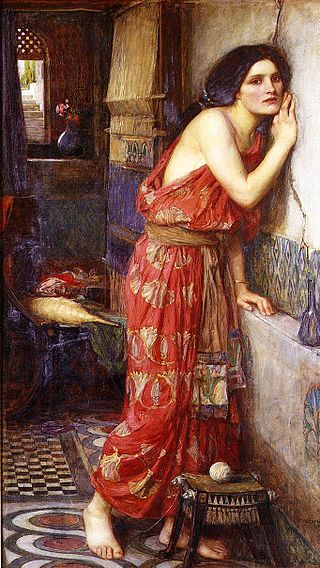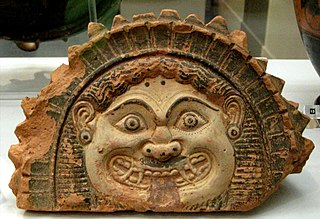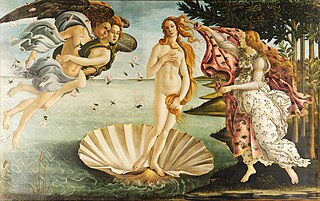Related Research Articles

In Greek mythology, Adonis was the mortal lover of the goddess Aphrodite and Persephone, who was famous for having achieved immortality. He was widely considered to be the ideal of male beauty in classical antiquity.

Pyramus and Thisbe are a pair of ill-fated lovers whose story forms part of Ovid's Metamorphoses. The story has since been retold by many authors.

In Ovid's Metamorphoses, Baucis and Philemon were an old married couple in the region of Tyana, which Ovid places in Phrygia, and the only ones in their town to welcome disguised gods Zeus and Hermes, thus embodying the pious exercise of hospitality, the ritualized guest-friendship termed xenia, or theoxenia when a god was involved.

Myrrha, also known as Smyrna, is the mother of Adonis in Greek mythology. She was transformed into a myrrh tree after having intercourse with her father, and gave birth to Adonis in tree form. Although the tale of Adonis has Semitic roots, it is uncertain where the myth of Myrrha emerged from, though it was probably from Cyprus.

In Greek mythology, Icarus was the son of the master craftsman Daedalus, the architect of the labyrinth of Crete. After Theseus, king of Athens and enemy of Minos, escaped from the labyrinth, King Minos suspected that Icarus and Daedalus had revealed the labyrinth's secrets and imprisoned them—either in a large tower overlooking the ocean or the labyrinth itself, depending upon the account. Icarus and Daedalus escaped using wings Daedalus constructed from feathers, threads from blankets, clothes, and beeswax. Daedalus warned Icarus first of complacency and then of hubris, instructing him to fly neither too low nor too high, lest the sea's dampness clog his wings or the sun's heat melt them. Icarus ignored Daedalus’s instructions not to fly too close to the sun, causing the beeswax in his wings to melt. Icarus fell from the sky, plunged into the sea, and drowned. The myth gave rise to the idiom, "fly too close to the sun."

The Metamorphoses is a Latin narrative poem from 8 CE by the Roman poet Ovid. It is considered his magnum opus. The poem chronicles the history of the world from its creation to the deification of Julius Caesar in a mythico-historical framework comprising over 250 myths, 15 books, and 11,995 lines.

Thomas Bulfinch was an American author born in Newton, Massachusetts, known best for Bulfinch's Mythology, a posthumous combination of his three volumes of mythologies.

In Greek mythology, Medusa, also called Gorgo, was one of the three Gorgons. Medusa is generally described as a human female with living venomous snakes in place of hair; those who gazed into her eyes would turn to stone. Most sources describe her as the daughter of Phorcys and Ceto, although the author Hyginus makes her the daughter of Gorgon and Ceto.

Classical mythology, also known as Greco-Roman mythology or Greek and Roman mythology, is the collective body and study of myths from the ancient Greeks and ancient Romans. Mythology, along with philosophy and political thought, is one of the major survivals of classical antiquity throughout later Western culture. The Greek word mythos refers to the spoken word or speech, but it also denotes a tale, story or narrative.
Euhemerus was a Greek mythographer at the court of Cassander, the king of Macedon. Euhemerus' birthplace is disputed, with Messina in Sicily as the most probable location, while others suggest Chios or Tegea.
Euhemerism is an approach to the interpretation of mythology in which mythological accounts are presumed to have originated from real historical events or personages. Euhemerism supposes that historical accounts become myths as they are exaggerated in the retelling, accumulating elaborations and alterations that reflect cultural mores. It was named for the Greek mythographer Euhemerus, who lived in the late 4th century BC. In the more recent literature of myth, such as Bulfinch's Mythology, euhemerism is termed the "historical theory" of mythology.
Thomas Keightley was an Irish writer known for his works on mythology and folklore, particularly Fairy Mythology (1828), later reprinted as The World Guide to Gnomes, Fairies, Elves, and Other Little People.

Clytie, or Clytia is a water nymph, daughter of the Titans Oceanus and Tethys in Greek mythology. She is thus one of the 3,000 Oceanid nymphs, and sister to the 3,000 Potamoi.

In Greek and Roman mythology, Corone is a young woman who attracted the attention of Poseidon, the god of the sea, and was saved by Athena, the goddess of wisdom. She was a princess and the daughter of Coronaeus. Her brief tale is recounted in the narrative poem Metamorphoses by the Roman poet Ovid. Several other myths surround the crow about its connection to Athena.

With the rediscovery of classical antiquity in the Renaissance, the poetry of Ovid became a major influence on the imagination of poets and artists, and remained a fundamental influence on the diffusion and perception of classical mythology through subsequent centuries. From the early years of the Renaissance, artists portrayed subjects from Greek and Roman mythology alongside more conventional Christian themes. Among the best-known subjects of Italian artists are Botticelli's Birth of Venus and Pallas and the Centaur, the Ledas of Leonardo da Vinci and Michelangelo, and Raphael's Galatea. Through the medium of Latin and the works of Ovid, Greek myth influenced medieval and Renaissance poets such as Petrarch, Boccaccio and Dante in Italy.
The abbé Antoine Banier, a French clergyman and member of the Académie des Inscriptions et Belles-Lettres from 1713, was a historian and translator, whose rationalizing interpretation of Greek mythology was widely accepted until the mid-nineteenth century.

Greek mythology is the body of myths originally told by the ancient Greeks, and a genre of ancient Greek folklore, today absorbed alongside Roman mythology into the broader designation of classical mythology. These stories concern the ancient Greek religion's view of the origin and nature of the world; the lives and activities of deities, heroes, and mythological creatures; and the origins and significance of the ancient Greeks' cult and ritual practices. Modern scholars study the myths to shed light on the religious and political institutions of ancient Greece, and to better understand the nature of myth-making itself.
Myth is a genre of folklore or theology consisting primarily of narratives that play a fundamental role in a society, such as foundational tales or origin myths. For folklorists, historians, philosophers or theologians this is very different from the use of "myth" which simply meaning something that is not true. Instead, the truth value of a myth is not a defining criterion.

In Greek mythology Leucothoe was a Babylonian princess. The daughter of Orchamus, a king of Persia, Leucothoe was either a lover of the sun god Helios or a victim of rape. A nymph or Leucothoe's own sister named Clytie, who loved Helios and was jealous of Leucothoe, informed Leucothoe's father that Leucothoe, despite being unmarried, was no longer a virgin, whereupon Orchamus buried his daughter alive in punishment. Helios then transformed Leucothoe's dead body into a frankincense tree.

Themes of transformations are found in all types of mythologies and folklore. Greek mythology features a wide collection of myths where the subjects are physically transformed, usually through either divine intervention or sorcery and spells. Stories of shapeshifting within Greek context are old, having been part of the mythological corpus as far back as the Iliad of Homer. Usually those legends include mortals being changed as punishment from a god, or as a reward for their good deeds. In other tales, gods take different forms in order to test or deceive some mortal. There is a wide variety of type of transformations; from human to animal, from animal to human, from human to plant, from inanimate object to human, from one sex to another, from human to the stars (constellations).
References
- ↑ Richard 2009, p. 33.
- 1 2 Talbot 2017, p. 75.
- ↑ Cleary 1987, p. 12.
- ↑ Hawkins & Poe 2018, p. 223.
- 1 2 3 Talbot 2017, p. 84.
- 1 2 3 Cleary 1985, p. 591.
- ↑ Montfort 2013, pp. 141–42.
- ↑ Cleary 1987, p. 15.
- ↑ Bulfinch 2004, p. vii.
- ↑ Montfort 2013, p. 142.
- 1 2 3 Cleary 1987, p. 13.
- 1 2 Miller & Newlands 2014, p. 247.
- ↑ Miller & Newlands 2014, pp. 247–48.
- 1 2 3 4 Cleary 1987, p. 14.
- ↑ Talbot 2017, p. 77.
- ↑ Cleary 1985, pp. 593, 595.
- 1 2 Cleary 1985, p. 595.
- ↑ Cleary 1985, pp. 594.
- 1 2 3 Talbot 2017, p. 78.
- ↑ Guide to Reference Books, 1929, p. 89.
- ↑ Brazouski & Klatt 1994, p. 28.
Bibliography
- Richard, Carl J. (2009). The Golden Age of the Classics in America: Greece, Rome, and the Antebellum United States. Harvard University Press. ISBN 978-0-67403264-4.
- Cleary, Marie S. (1985). "Miscuit utile dulci: Bulfinch's Mythology as a pedagogical prototype". Classical World. 78 (6): 591–96. doi:10.2307/4349766. JSTOR 4349766. Archived from the original on 2006-07-20. Retrieved 2015-08-19.
- ——— (1987). "Bulfinch's Mythology". Humanities. National Endowment for the Humanities. 8 (1): 12–5.
- Montfort, Bruno (2013). "Thoreau's work on myth: The modern and the primitive". In Specq, François; Walls, Laura Dassow; Granger, Michel (eds.). Thoreauvian Modernities: Transatlantic Conversations on an American Icon. University of Georgia Press. ISBN 978-0-82034428-7.
- Miller, John F.; Newlands, Carole E., eds. (2014). A Handbook to the Reception of Ovid. John Wiley & Sons. ISBN 978-1-11887618-3.
- Adams Leeming, David, ed. (1991). The World of Myth: An Anthology. Oxford History of the United States. Oxford University Press. ISBN 978-0-19987896-3.
- Talbot, John (2017). "Bulfinch and Graves: Modern mythography as literary reception". In Zajko, Vanda; Hoyle, Helena (eds.). A Handbook to the Reception of Classical Mythology. Wiley Blackwell Handbooks to Classical Reception. John Wiley & Sons. ISBN 978-1-44433960-4.
- Bulfinch, Thomas (2004). Scott, J. Loughran (ed.). The Age of Fable, Or, Beauties of Mythology. Biblo & Tannen. ISBN 978-0-81962810-7.
- Hawkins, Aileen; Poe, Alison (2018). "Narcissus in children's contexts: didacticism and scopophilia?". In Hodkinson, Owen; Lovatt, Helen (eds.). Classical Reception and Children's Literature: Greece, Rome and Childhood Transformation. Bloomsbury Publishing. ISBN 978-1-78672329-1.
- Brazouski, Antoinette; Klatt, Mary J., eds. (1994). Children's Books on Ancient Greek and Roman Mythology: An Annotated Bibliography. Bibliographies and indexes in world literature. Vol. 40. Greenwood Publishing Group. ISBN 978-0-31328973-6. ISSN 0742-6801.